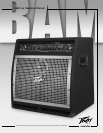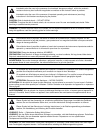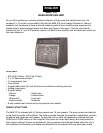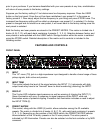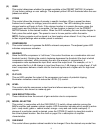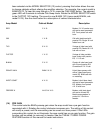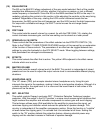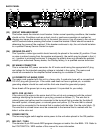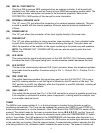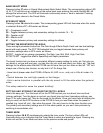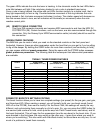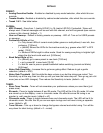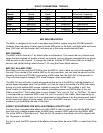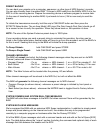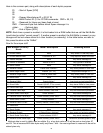
9
(28) MIDI IN / FOOTSWITCH
This 8-pin DIN is receives MIDI commands from an external controller. It will accept both
standard 5-pin DIN cables as well as Peavey’s 8-pin MIDI/Communication combo cable. The
8-pin cable provides connection and power to the footswitch (supplied). Refer to the
FOOTSWITCH / MIDI section of this manual for more information.
(29) EXTERNAL SPEAKER JACK
This 1/4" mono (TS) jack allows the connection of an external speaker cabinet(s). The jack
is wired in parallel with the internal speakers. Minimum external enclosure impedance is
4 Ohms.
(30) POWER AMP IN
This 1/4" jack allows the connection of line level signals directly to the power amp.
(31) PREAMP OUT
This 1/4" jack allows patching to mixing consoles, tape recorders, etc. Use a shielded cable
to patch from this jack to the input of the device receiving the signal. This patch does not
affect the operation of the amplifier or the signal continuing to the power amp and speakers.
NOTE: The PREAMP OUT / POWER AMP IN jacks can also be used to patch line level
effects units.
(32) XLR LEVEL
This control sets the signal level being sent out the XLR OUTPUT (33). Clockwise rotation
increases the level of the signal being sent; counterclockwise rotation decreases the level.
(33) XLR OUTPUT
This low-noise, electronically balanced XLR (3-pin) connector allows low-impedance patches
to be made from the amplifier. Connector wiring is: Pin 1 = Ground; Pin 2 = Positive; Pin 3 =
Negative.
(34) PRE / POST EQ
This switch determines whether the signal being sent from the XLR OUTPUT (33) is pre or
post-EQ, meaning whether or not that signal is affected by the EQ section of the amp. The
OUT position is pre-EQ (not affected), while the IN position is post-EQ (affected), including all
modeling, compression and effects.
(35) GND / GND LIFT
This switch lifts the ground from Pin 1 of the XLR connector to prevent a possible ground loop
if the amplifier is connected to another piece of equipment, a mixing board for example, that
is on another electrical circuit.
TUNER
The BAM’s tuner accommodates 4, 5, or 6-string basses in standard tuning formats as well as
functioning chromatically. The Tuner can be accessed by pressing the USER (5) and STORE (6)
buttons simultaneously, or via the footswitch. (See Tuner Mode in the FOOTSWITCH section of this
manual.) The default mode for the tuner is standard bass tuning (B E A D G C), and the Tuner will
be in this mode when selected. To enter the chromatic mode, press the COMPRESSOR (7) button
while in Tuner Mode. The LED adjacent to the COMPRESSOR will illuminate when the tuner is in
the chromatic mode. The LED displays for controls 14 –16 function as strobe-style indicators relative
to the note they are tracking. (See the diagram below.) Counterclockwise rotation indicates that the
note being tracked is flat; clockwise rotation indicates the note is sharp. The speed of rotation will



